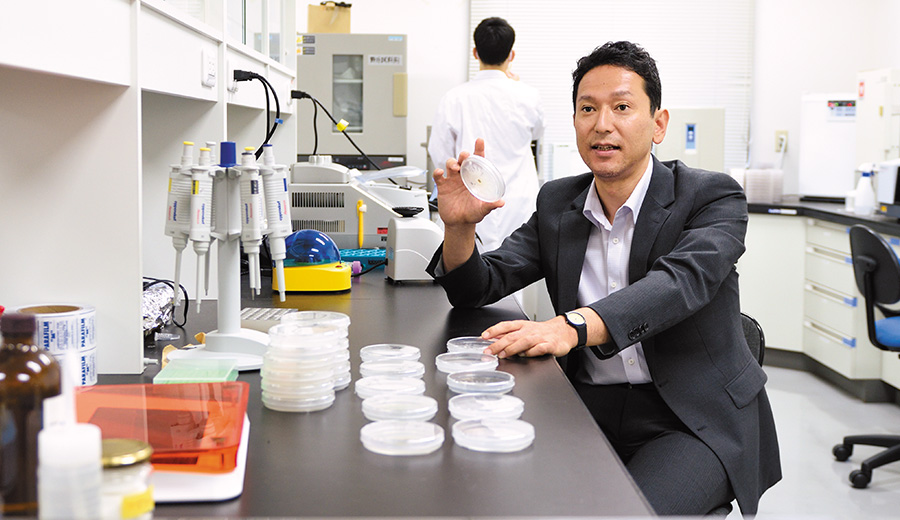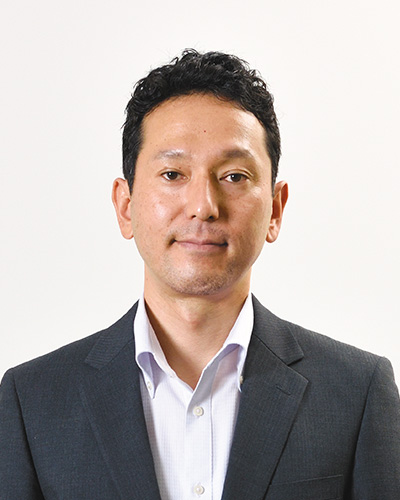Interview with researchers 10 Analyzing the diversity of fungi worldwide to explore their ecology in a changing global environment

- Interview Takashi Osono
- Professor,
Faculty of Science and Engineering,
Department of Environmental Systems Science
Microbes impact the global environment
While mushrooms, mold, and other fungi are organisms that are commonly seen in our daily lives, there is still much to be unraveled concerning their ecology. Some estimate that there are more than 1.5 million species of fungi on earth, which is a far greater diversity than that of the 270,000 plant species. Of the estimated 1.5 million species, only about 100,000 species have been discovered by humanity. Prof. Osono (Faculty of Science and Engineering), who was drawn by these major mysteries, is focusing his research on fungi, which have lagged behind research on plants and animals. “Ecology is the study of the relationship between organisms and environment, and it developed primarily through the study of plants and animals,” Osono explained. “Many of the fungi I study live in filamentous cells called mycelia. Mycelia as a research subject presented me with many challenges, as they not only lack morphological characteristics, but are also so extremely small that they are not visible to the naked eye, in addition to being too diverse to be counted. Furthermore, in the past, it was necessary to culture the fungi collected during fieldwork, and it took a long time and effort to identify them. However, the scientific and technological advancements over the last 30 years have contributed to steady progress in the field of fungal ecology. In particular, with the advent of a technique called DNA barcoding, it is now possible to analyze the DNA sequences of fungi and identify their species, which has dramatically increased the speed of research.”
Prof. Osono cites mycelium as a characteristic element of fungi. The mushrooms and mold we can see are reproductive cells that produce and disperse spores, but mycelia are the trophic cells that make up their main body. “Like blood vessels that course through the human body and deliver the necessary nutrients, the hyphae extend and branch out at a diameter of about 2 to 10 μm, spreading throughout the soil and fallen leaves. They can adjust their growth to their environment, making some mycelia live for more than 1,000 years,” Osono explains. Plants have rigid cell walls made of a compound called lignocellulose, which consists of lignin and cellulose. Mycelia decompose lignocellulose through extracellular enzymes and absorb their nutrients (Figure 1). “Fungi are the only organisms on the planet that can completely decompose lignocellulose. In other words, fungi play an important role in the ecosystem by decomposing fallen leaves and returning them to the soil. Among other things, fungi can also decompose dioxins, which tells us how important they are as a biological resource as well.”

(Fig. 1) Gymnopus dryophilus and a fallen leaf from Castanopsis sieboldii that turned white due to Lignin decomposition
Exploring fungal ecology: from Kyoto to the tropics and polar regions
Prof. Osono started his research on the decomposition process of fallen leaves and the physiological ecology of fungi involved in decomposition in a beech forest in Kyoto. In temperate Kyoto, fungi that can actively decompose lignin (lignin-degrading fungi) were not well established. On the other hand, he frequently saw lignin-degrading fungi in tropical forests in Thailand, which caused him to take notice of the climate zones. Furthermore, he has expanded research to Australia, Canada, the Arctic, and to Antarctica (Figure 2). Analysis based on data collected over nearly two decades revealed the diversity of fungi along climatic gradients, as well as their functions and their relationship to environmental factors. “The study found that there are two types of lignin degradation. The first type is typically found in Okinawa and Thailand is more active in lignin decomposition, whereas the second type is common in temperate and polar regions.” Since 2007, he has published more than 80 papers in international journals such as Fungal Diversity, Fungal Ecology, and Plant and Soil. He was a recipient of the Oshima Award from the Ecological Society of Japan for his achievements —receiving high acclaim domestically and internationally.

(Fig. 2) A view of Lützow-Holm Bay, Skallen Hills, Antarctica (69° South)
Furthermore, his recent studies have investigated where the two types of lignin decomposition, switch in Japan. In the process, a correlation was discovered that the higher the latitude, the lower the lignin-degrading activity of fungi. “It turned out that, instead of switching from one type to another at a certain point, they gradually change along with the environment” Osono explains. This finding provides valuable baseline data for predicting the effects of temperature changes, such as global warming, on the ecosystem.
The interest of Prof. Osono, who studies the environment surrounding fungi, is also directed toward the Australian tropical rainforest. The rainforest in Australia, which conveys the appearance of the tropical forests on the continent of Gondwana more than 100 million years ago, is known for its distribution of many endemic plants, but information on fungi has been limited. Thus, Prof. Osono conducted a fungal survey in this rainforest. “Through a series of studies, we found that fungi of the family Rhytismataceae are involved in lignin decomposition of fallen leaves of trees belonging to families, such as, Lauraceae, Proteaceae, and Myrtaceae, which also flourish in subtropical Okinawa. By comparing this geographical information with the evolutionary paths that organisms have followed, we can find clues as to how the relationship between fungi and plants has evolved over time and space. As a researcher, I find no shortage of interest,” he said.
Accelerate research with a new facility that links the field and lab
Professor Osono has published various findings from his research over the years. He says that his research will be taking two paths forward. “The first is research on a group of fungi called endophytes, which infect living plants. The Rhytismataceae belongs to this group, too. When plants are infected with endophytes, there is a positive effect on the plant, such as stimulation of the plant growth or that development of drought resistance, but the ecology of this effect is not well understood. The other path is to engage in collaborative research at the poles. The project from the 2018 Arctic survey is still ongoing. Although the COVID-19 crisis has prevented us from going to the field site, we have collaborators who provide samples and work hard to study fungi and plants in the Arctic and Antarctica. As this is a great field suitable for exploring the relationships between organisms and the environment, it is quite exciting.”
The scope of research has also expanded to solving problems through industry-government-academia collaboration. A joint study was conducted with Shiga Prefecture, the Ohmi Environment Conservation Foundation, and the Research Institute for Humanity and Nature to examine measures for environmental conservation, aiming to effectively utilize the overgrowth of aquatic plants in Lake Biwa. “Examining the physiological and ecological characteristics of fungi is our specialty. As a vision for future researches, we are considering the establishment of a research facility that can combine a biological growth chamber with a controlled environment. I would like to accelerate the type of research that links the field and the lab, and I wish people could utilize our discoveries and findings in various fields.” Prof. Osono’s research, which opens the uncharted field of fungal ecology, is garnering further attention.

